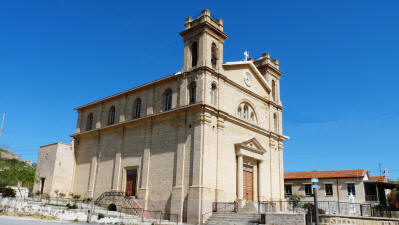Ayios Georgios Maronite Church
Korucam, Near Guzelyurt, North Cyprus
The church is in the village of Korucam, still referred locally by its pre 1974 name of Kormakitis, where most of the Maronite population of North Cyprus live.
The Maronites are an ancient Middle Eastern Christian sect, centred in the Lebanon, where they are one of the principal religious groups.
St Maron (350 - 410AD) was a monk, and friend of St John Chrysostom, one of the greatest early church founders. He left Antioch (modern day Antakya) to lead a frugal life around mount Taurus. He soon had many followers, and after his death, they built a monastery in his memory, forming the nucleus of the Maronite Church.
The death of the Patriarch of Antioch in 602, left the Maronites without a leader, and in 685, they elected their own Patriarch, which did not go down well with the Orthodox Church, leading to their affiliation with the Latin Church. Over the next few hundred years, the Maronites gradually migrated to the mountains of Lebanon.
 |
| Ayios Georgios Church |
During the Crusades of the 12th century, the Maronites assisted the Crusaders, reaffirming their affiliation with Rome. Some Maronites are supposed to have come to Cyprus in the 12th Century with the Crusaders, settling mainly in the Korucam and Karpaz areas, although there is some evidence of a Maronite colony being on the island from the 7th century. The main exodus, however, followed the siege and loss of Acre in 1291.
After the takeover of the island by the Ottomans, the Maronites found themselves marginalised from two directions; the Ottomans punished them for their support of the Venetians and their linking to the Latin Church, and by the Orthodox Church for their specific brand of Christianity. During the Ottoman rule, 14 Maronite villages became extinct as their inhabitants moved out. During this period, the Ottomans had placed the church under the jurisdiction of the Orthodox Church. However 1840, this ruling was removed.
Although recognising the supremacy of the pope (they call themselves Catholics), the Maronites have always been culturally similar to the Orthodox Church, for example celebrating Easter on the Orthodox rather than the Latin dates.
During the struggles between the Greek Orthodox and Turkish Muslim communities, they attempted to remain neutral, taking no part in the EOKA activities either before or after independence. They feel that the present situation in Cyprus is a direct result of pre 1974 government policy, and they bear little animosity towards Turkish Cypriots, frequently giving them food and shelter during EOKA activities during the lead up to the events of 1974. Consequently, they were allowed to remain in the north after the events of 1974. That said, most of the Maronites in the area moved to the south, with those remaining mainly settling in the village of Korucam, where the population has gradually dwindled to around 150.
The TRNC government seized control of all lands belonging to Maronites living in the south, and some houses in Korucam were used to house Turkish officers and their families. With the relaxing of controls in 2003, living conditions have gradually improved, and the houses have been returned to their original owners.
A priest is still resident in the village, and mass is celebrated regularly in the church, especially on St Maran's feast day, the 9th February. If it is closed when you visit, you may be able to get the key from the municipal coffee house alongside.
Watch a video about the village of Korucam (Kormakitis), its churches, museum, and festival.
See the location on Google maps
Back to Guzelyurt index.